In the modern-day gold rush of technological innovations, Artificial Intelligence (AI) stands tall as one of the most ground-breaking developments. Imagine sitting in front of your screen, struggling with writer’s block or a lack of time. Wouldn’t it be fantastic if there was an intelligent assistant that could help you out? Enter AI blog writing. An AI can whittle down hours of strenuous writing to minutes! Join me on this captivating journey as we explore how to revolutionize blogging by using AI to write stellar blog posts.
What is AI Blog Writing?
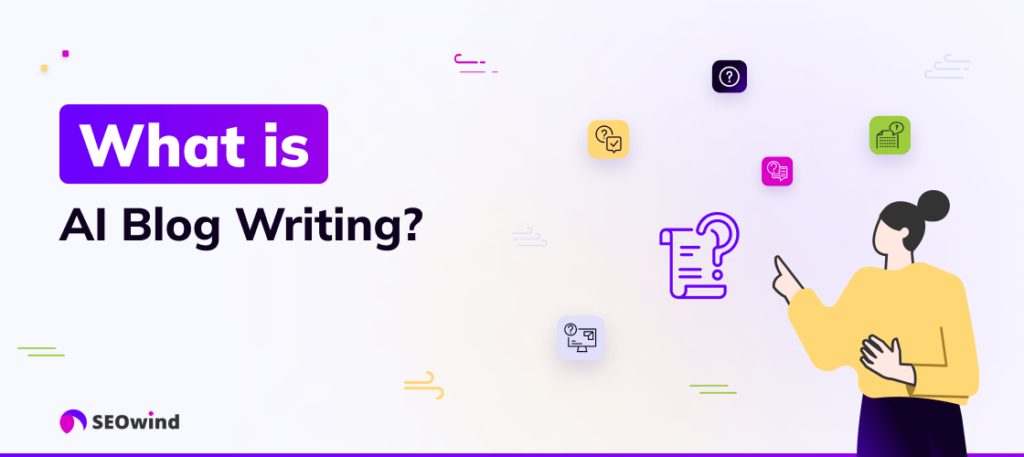
Let’s dispense with traditional pen-and-paper or fingers-over-keyboard writing for a moment and step into a world where creativity meets technology head-on. This is where Artificial Intelligence (AI) shines.
AI blog writing refers to making use of highly innovative algorithms that are capable of producing written content with ease. Using complex machine learning techniques, these algorithms have been trained on vast arrays of online text, enabling them to string together words and form contextually relevant sentences.
And mind you, this isn’t just mundane robo-talk; these algorithms can create engaging narratives, produce informative articles, and even weave intriguing, attention-grabbing stories. Infused with fluency akin to human writers, AI blog post writers effortlessly amalgamate keyword research, SEO strategies, and readability considerations while adhering to specific brand voices or tones.
However, remember one golden rule: behind every great piece of AI-written material is an insightful human touch guiding it. That’s why I’ll use this opportunity to discuss both the use of AI for blog writing and tips on collaborating effectively with AI by treating it as our trusted ally rather than a threatening foe. So, fasten your seatbelts because we’re about to take off!
Core Principles of Using AI to Write Blog Posts
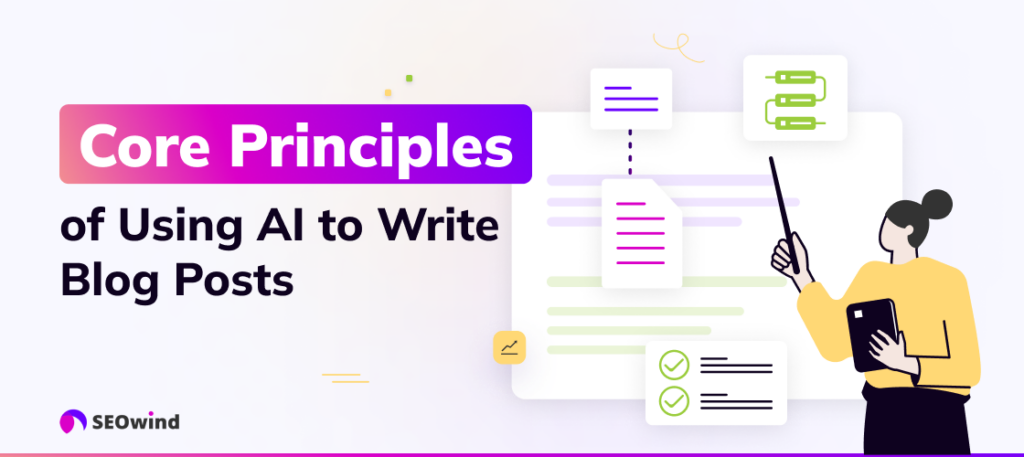
It’s all about knowing how to harness the potential of AI for blog writing. With a firm grasp of its intricacies, you can revolutionize blogging on your platform. Let me guide you through the chief principles I use when employing AI to write blog posts.
It’s All About Context – Do the Research
As with traditional content creation, context forms the bedrock of using AI in blog writing. You must undertake extensive content research before feeding information into an AI tool.
Start by understanding your audience demographics and their needs. Next, determine popular topics within your niche related to that demographic. Finally, identify SEO keywords associated with these topics.
This legwork will help you generate broader contextual parameters for an AI blog post writer.
State Your Objective for The Content
Articulating clear objectives is another fundamental aspect of using AI-generated blog posts. This means identifying precisely what you hope to achieve with each particular piece.
The objective could be anything from driving traffic to promoting a product or fostering engagement. Whatever it might be, stating it clearly will dictate crucial elements of the content, such as title choice, keyword selection, and the overall structure of the AI-generated blog post.
Set Your Requirements – AI Cannot Read Your Mind
Contrary to popular belief and Hollywood stereotypes, Artificial Intelligence is not omniscient! Although sophisticated algorithms power these tools, enabling them to produce high-quality work, they are ultimately as effective as the directions offered to them.
Herein lies one more necessary aspects of using AI for blog writing: setting specific requirements for the task at hand, such as:
- Preferred length
- Tone/style
- SEO keyword density
- References or examples.
Your clear instructions can ensure a fitting output with little editing effort required.
Write A Brief And Outline – Working With AI Doesn’t Differ That Much From Working With Humans
In fact, the approach to using AI to write blog posts is very similar to collaborating with a human writer. Crafting a brief and detailed outline still remains paramount.
A comprehensive brief might include:
- Content objective and target audience
- Key points or sections that must be included
- Keywords.
On the other hand, an outline will furnish your AI tool with a clear roadmap to follow when generating text.
Define Brand Voice So AI Blog Posts Sound Like You
Using AI for writing blogs doesn’t mean surrendering your brand’s unique voice. Far from it, you can calibrate Artificial Intelligence to reflect your characteristic tone and style, ensuring each AI-written blog post retains your identity.
Define key aspects of your brand voice, such as:
- Formality level
- Phrasing preference
- Preferred tense usage
- Choice of vocabulary.
By integrating these essential guidelines, you command an AI blog post writer tool to create consistent content that retains a personalized touch. It’s akin to having another version of yourself penning these engaging pieces online!
Advantages of Using AI for Blog Writing
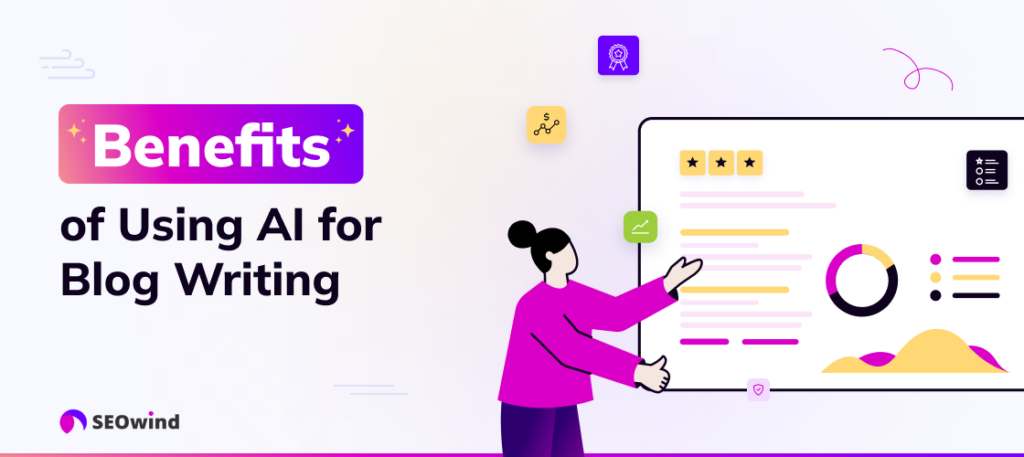
The use of Artificial Intelligence in content creation, specifically blog writing, is growing quickly. This ascent doesn’t occur in a vacuum. This expansion is based on several advantages associated with using AI to write blog posts, from saving valuable resources like time and money to boosting efficiency and generating unique content.
Saving Time and Money
Through the age-old adage “time is money,” we know that any tool or methodology that streamlines processes inevitably results in resource preservation. Most often, this is primarily realized in time and cost savings. By utilizing an AI blog writer tool, you can do just that by:
- Reducing countless hours spent researching and drafting to minutes. Innovative AI algorithms conduct rudimentary yet essential tasks faster than any human writer can.
- Reducing the financial burden of hiring an extensive team of writers. With an effective AI blog post writer at your disposal, you’re harnessing a tireless digital scribe without concerns about sick leaves, weekend breaks, or remunerations.
Improving Efficiency
In addition to direct savings, another enticing advantage is improved efficiency. Through its ability to process colossal amounts of data swiftly while interpreting complex instructions, using AI tools for blog writing empowers you to:
- Craft engaging content rapidly. Speed can often be critical, whether we’re talking about rapid news updates or viral trend reviews.
- Juggle multiple projects effortlessly. An AI assistant makes managing diverse writing assignments concurrently less daunting.
Within this matrix of enhanced productivity lies the opportunity to focus more on strategic tasks such as planning promotional campaigns or improving SEO strategies.
Generating Unique Content
Let’s remember one of the most appealing aspects of this technology: the innovative expression capacity ingrained within these smart processors! A well-optimized AI algorithm efficiently delivers unique content, conforming flawlessly with context appropriation and coherency norms.
While AI can create impressive drafts, the final touch still requires human intervention. This combination ensures that AI content remains authentic and retains your brand’s unique voice.
When used intelligently, AI blog writing not only revolutionizes the traditional rules of blogging but also presents an opportunity to focus on elevating other aspects of your digital strategy. While this technology isn’t meant to replace human creativity fully, it certainly bolsters it. Now, are you ready for a test drive?
Disadvantages of Using AI for Blog Writing
As much as embracing Artificial Intelligence for blog writing promises many benefits, it’s also crucial to understand the drawbacks. Let’s shed light on some limitations you might encounter when you use AI to write blog posts.
Lack of a Human Touch
A significant drawback of utilizing AI for blog writing is its inherent lack of the human touch. Though sophisticated in many ways, AI can’t flawlessly mimic the essence and warmth that human-generated content often exudes.
- Reading between the lines: Unlike humans, an AI writer cannot understand and interpret subtleties and nuances typically present in various forms of communication. A joke or satire that would naturally make your readers chuckle may fail to elicit such a response when delivered by an AI blog post writer.
- Emotional narrative: Empathy is yet another characteristic trait unique to humans and missing from the toolkit of any AI blog writer. Humans connect with emotion-laden stories; sadly, AI doesn’t yet excel at weaving emotional narratives.
- Untapped creativity: The human imagination is limitless, which isn’t carried over as part of an algorithmic phenomenon like Artificial Intelligence.
While trained algorithms are making impressive strides toward cognitive flexibility, they’re not yet elegant enough to capture all facets of a human author.
Inaccuracies in Content
The second critical challenge is related to faulty accuracy and factual correctness. Remember that even if you use AI-generated blog posts, they need supervision!
- Dependence on training data: Using AI to write articles or blogs largely relies on the data quality and diversity used to train these models.
- Semantic inconsistencies: Inconsistencies sneak into the picture despite the success achieved so far. Sometimes, generated sentences may contradict each other, leaving readers in a state of confusion.
- Fact-checking: AI cannot independently verify data and statistics. Ultimately, that responsibility reverts to the human writer maintaining fidelity.
AI may be getting smarter every day, but it’s only as accurate as the data fed into it. Without meticulous human oversight, there’s a heightened risk of inaccuracies sneaking into your articles.
Using AI to write blog posts is an exciting prospect with its own set of pros and cons. While it can save considerable amounts of time and substantially increase efficiency, linguistic subtleties and accuracy remain serious challenges that must be acknowledged and addressed! Using technology optimally means balancing its potency with human creativity and supervision. To see the best results from blog post AI, ensure that each article isn’t just primed for SEO optimization but also resonates on a decidedly human level!
SEOwind – the Best Tool to Write AI Blog Posts
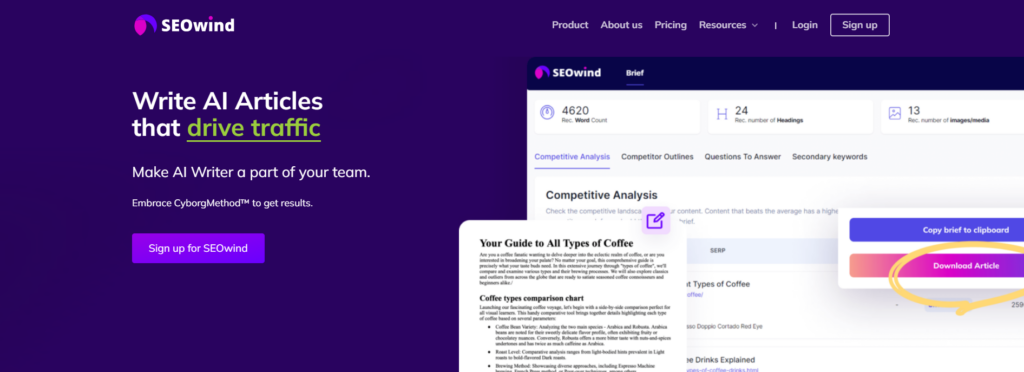
Let’s dive into how a powerful tool like SEOwind can completely transform your blog-writing operations and significantly influence your overall blogging success.
Generate Brief and Blog Outline
The first step to using AI to write blog posts involves generating a brief and an outline for your content. This is where SEOwind shows its incredibly intuitive capabilities. With the input of a few keywords or main ideas, it autonomously drafts a comprehensive brief that distinctly spells out key points. Additionally, it creates an organized outline, structuring the flow of your post and ensuring logical consistency from start to finish.
Conduct Content and Keyword Research
The engine powering SEOwind specializes in streamlining one of the most time-consuming elements of blog writing: research. The AI unleashes itself onto millions of articles, gathering relevant context about a given subject. It also conducts keyword research, identifying primary and secondary keywords optimal for boosting visibility in search engine results.
Define Brand Voice
Your brand voice can be as diverse as the creative minds behind it, adding another layer of complexity when training an AI. Despite these challenges, defining your brand voice with SEOwind is simple! You just set specific parameters such as tone style (casual or formal), vocabulary preferences (simple or complex), and information density (sparse or dense). Within minutes, this AI blog writer assimilates all that information, feeding its output only what suits you best.
Write an AI Blog Post
Once furnished with all the discussed ingredients, a well-structured brief, and intensively researched keywords that resonate with a defined brand voice, we reach the final chapter: drafting the actual blog post! Watch in awe as SEOwind takes over labor-intensive tasks! It puts together grammatically accurate sentences and shapes them elegantly into engaging narratives while keeping them simple enough for easy comprehension by your target audience.
Bloggers no longer have to navigate complex word mazes. Instead, they can guide AI platforms like SEOwind to conjure gripping content. So, why not give Artificial Intelligence blog post writing a try? After all, every revolution begins with trying something new!
Other Popular AI Blog Writing Tools
In the realm of Artificial intelligence (AI) blog writing, several powerful tools have risen to prominence. These offer various features meant to ease your content creation process. Allow me to take you on a brief journey through four popular AI-powered digital writing assistants that can revolutionize the way we create captivating blog posts.
Copy.ai
At the forefront is Copy.ai, a dynamic tool designed for versatility. This tool does an excellent job when you need to brainstorm ideas or generate first drafts rapidly. Whether you need AI-generated blog posts, ad copies, or catchy headlines, this tool provides them with relative ease. Remember that, like any AI solution, human oversight ensures quality and relevance.
Jasper
Next on our tour is Jasper, previously known as Jarvis.ai. What sets Jasper apart from others is its ability to write long-form content efficiently. With “Boss Mode,” this tool takes AI in blogging to another level. It learns your instructions given in conversational English and delivers accordingly. If you struggle for expressions while maintaining continuity in your posts, keep Jasper in mind.
Scalenut
Scalenut deserves special mention for easing keyword optimization in AI-written blogs. This is particularly crucial if SEO-focused content tops your agenda. Its unique selling point is automatically creating optimized tags and meta descriptions while sticking close to a user-defined brief. Consider Scalenut an ideal ally when prioritizing quantity and search engine visibility.
HyperWrite
HyperWrite wraps up our list with its primary feature: real-time content optimization using GPT-3 technology. This tool is best suited to churning out short, structured pieces such as social media captions or product descriptions. It excels at tasks where punchy text must convey a great deal within limited space constraints. So, give HyperWrite a go when brevity matters just as much as impact.
These cutting-edge AI blog writing tools redefine standard practices about using AI to write blog posts. Now, the decision is yours. Analyze your unique needs, test these tools yourself, and then decide which friendly AI comrade will make a spot in your content strategy.
How I use AI to write blog posts with SEOwind – the CyborgMethod™
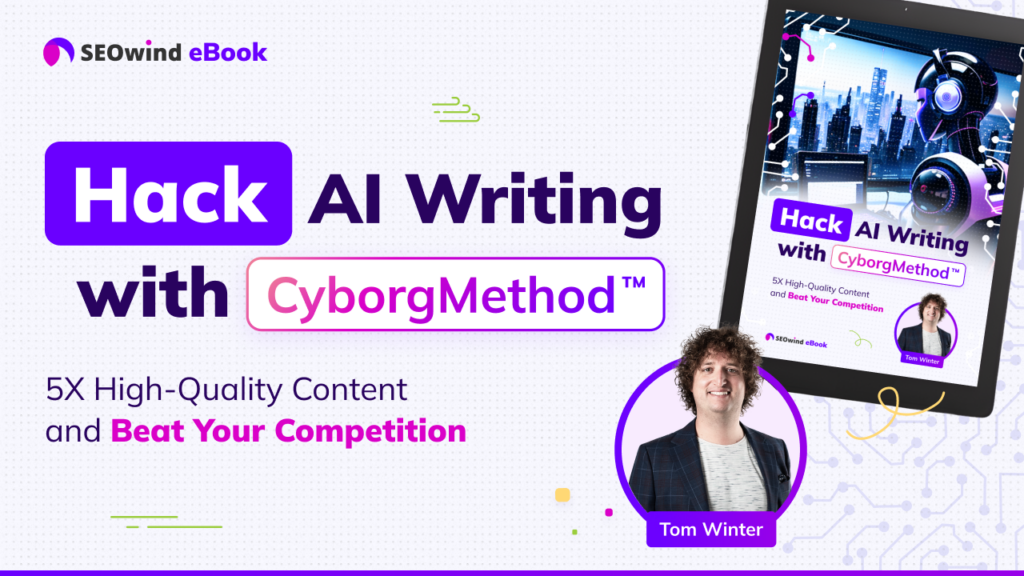
In an unusual twist on the classic tale of man versus machine, I propose a collaboration between human intellect and Artificial Intelligence. Welcome to my approach, which I affectionately call the “CyborgMethod™.” It’s about utilizing AI for blog writing without surrendering that distinctly human touch. When using this method, I employ SEOwind, an innovative tool that harnesses AI to generate compelling blog content.
Combine Human Expertise with AI Efficiency
At first glance, it’s easy to see why one might be tempted to allow Artificial Intelligence (AI) to take complete control over their content creation process. The massive leaps in AI technology enable the creation of robust and comprehensive articles at speeds no human writer can match.
However tempting it may seem, we must not forget the value of our own expertise. After all, while machines excel at processing data rapidly and accurately, they lack our innate understanding of nuance, emotion, and resonance, the elements necessary for engaging storytelling.
So, instead of replacing humans with machines when creating articles geared toward readers’ hearts and minds, I advocate combining them synergistically. By using your unique viewpoints and empathy alongside the mechanical precision of tools like SEOwind, you’ll find that your productivity skyrockets while content quality remains consistently high.
More than anything else, this combination expands your ability to strategize and plan content while maintaining the personal engagement inherent to human writing, even when generating hundreds or even thousands of words daily! Now that’s some real efficiency!
Remember! Human creativity will never lose its relevance, even in the face of advanced technology like AI-generated blog posts.
Treat AI as Part Of Your Content Team
Have you ever considered treating your AI as a team member rather than just an efficient machine? It might sound unconventional, but it is one of the best ways to maximize what AI offers. I treat my automated tools like a dynamic collaborator by nurturing an enriching feedback loop.
Just like any team member, AI thrives on clear instructions and goals. So, instead of simply outsourcing entire articles to the program and rehashing online sources or databases, provide it with specific tasks and objectives tailored to your content needs.
AI-generated blog posts can become more enticing and meaningful when human emotion and creativity are involved to some degree. This collaboration balances well-researched facts and rapid production with empathy and narrative finesse.
A good starting point is considering where AI fits into your larger workflow. Whether it is generating catchy headlines, drafting main sections based on an established outline, or researching data for infographics, ensure that its outputs align seamlessly with your overall strategy.
The future of blogging rests not in machines taking over writing from humans but in acknowledging our strengths while addressing our weaknesses with the help of these incredibly capable tools.
Next, I’ll show you how I implement all this while maintaining authenticity and resonance in my blogs!
Create a Comprehensive Brief with AI
Mastering the art of using AI to write blog posts starts with creating a comprehensive brief. Here, I’ll show you how to utilize Artificial Intelligence to construct one.
Start with Keywords
To initiate your AI-assisted content journey, you must first commence with keywords. Specific phrases or words that express the central point of your blog post are essential. Getting this right means ensuring your offering aligns with readers’ searches.
Think of keyword selection as handing your AI tool a compass that guides its contextual understanding for crafting fitting material. Pre-determining relevant keywords prevents misguided explorations into unrelated territories of identification or interpretation by AI.
Create the Content Brief
Next, construct an inclusive content brief feeding considerable context into the AI. You don’t need to provide detailed instructions for every paragraph, but formulating an overview encapsulating what each section should cover is essential.
Remember, despite their impressive capabilities, these tools aren’t clairvoyant. Algorithmic systems only generate content based on what they have been directed to do.
Content and Keyword Research
Once the core idea is established through keywords and a content brief, it’s time for some investigative groundwork facilitated by automated content research.
This process involves gathering supporting data and going in-depth on chosen keyword strands; increasing specificity makes your piece more SEO-friendly and tailored for user queries.
Use AI Outlines for a Solid Beginning
After appropriate preparation comes structuring your blog, another forte of Artificial Intelligence! Using an outline generated by your chosen software paints a clear roadmap before diving into writing.
Armed with such blueprints, you can more easily overcome initial hurdles like writer’s block or uncertainty about where to begin, providing momentum from the get-go and enhancing productivity and efficiency.
Choose H2s & H3s With Potential
Compelling subheadings (H2s & H3s) are crucial to crafting engaging, well-organized, and SEO-friendly content. An intriguingly worded subheading can go a long way toward holding readers’ attention.
However, it’s about more than writing catchy phrases. Your subheadings must also be purposeful and organize your post into clearly separated sections corresponding with individual mini-topics. In addition, they have to remain logically connected to the central theme.
Check Out Google, Reddit, and Quora Questions
To ensure your AI-written blog post covers what your audience genuinely wants to know, you need to do some window-shopping on commonly asked questions across platforms like Google’s “People also ask,” Reddit or Quora threads. Utilizing these resources assures relevancy, garnering clicks and expanding total reading time.
Incorporate FAQs Into Your Outline
After harvesting relevant questions from the sources mentioned above, remember to incorporate them effectively into your outline. Formulating a dedicated FAQ segment can be an inclusive approach, but integrating through posts wherever they fit works just as well.
The key here lies in serving up your answers straightaway when users search for those specific queries, resulting in a delightfully convenient strategy!
Define Your Brand’s Tone of Voice
Lastly, defining your brand’s tone of voice is paramount before deploying AI tools to generate content.
Doing so helps maintain consistency throughout all the produced material and avoids abrupt divergence, which may break immersion for readers. Decide whether you want the blog to be professional and informative or more casual based on demographic targeting before feeding this vital piece of info to the robotics-enhanced writer-cum-learning-machine.
Add the Human Touch to AI-Generated Blog Posts
Even with the precise capabilities of Artificial Intelligence, remember that they are still machines at their core. These complex algorithms require human intervention and editing to serve as a reliable tool in blog post generation.
Fix Spelling and Grammar
While most AI-based tools are designed accurately for language processing tasks, they can trip over the complexities of spelling and grammar rules. Understanding this is vital for producing high-quality content, as grammar mistakes can damage your credibility. So, it’s advisable to carefully read those drafts before you publish something under your name or brand.
After generating an AI-written blog post, take time to review its linguistic accuracy by:
- Checking spellings. Are there any common typos or misused words?
- Ensuring that grammatical rules have been followed correctly.
- Confirm if the punctuation used by the AI blog writer enhances readability.
Change Tone
Artificial Intelligence is impressive when it comes to data analysis, keyword incorporation, and formatting. However, setting the right tone still remains outside its robust capabilities.
Readers enjoy conversational pieces that engage them actively. Sometimes, AI-generated blogs miss this subtlety and come across as more mechanical than intended.
To overcome this challenge when using AI to write blog posts:
- Review how colloquial phrases have been handled. Do you need to make appropriate replacements?
- Asses if direct speech, compared to reported stories, would add life.
- Check whether personal experiences or anecdotes will make it more relatable.
Increase or Decrease the Length
Post length depends largely on topic complexity and reader demographics. More technical topics geared toward professional audiences usually demand detailed explanations. In contrast, readers typically enjoy breezy writing when engaging with casual subjects.
You need to guide the AI blog post writer and establish a preferred content length. You can either:
- Add more detail if your blog seems shorter than expected –
- Add more explanations or examples.
- Use quality research to provide additional context.
- Or reduce informational overflow –
- Identify and trim repetitive text.
- Combine closely related concepts into a single section.
You are the ultimate editor when harnessing AI-written blogs. After all, it is through this harmonious collaboration of human creativity with technological efficiency that we achieve truly stellar blogging.
I can almost hear you asking, “Can I use AI to help write my blog posts?” The response is a resounding yes! Artificial Intelligence has splashed onto the blogging scene like a comet streaking across the night sky, and it’s relevant for everybody.
AI for writing blogs isn’t about robotic content creation. Instead, it’s about transforming yourself into an AI-powered blogger, using intelligent tools as your secret writing allies. The “cyborg” approach of blending human creativity with AI efficiency allows you to take full advantage of AI blog writing.
Utilizing AI blog post writer tools is neither exclusive nor complicated. Whether you’re starting out your journey as a fledgling blogger or running a multi-blog platform, you have the power to use AI to write blog posts. It all entails integrating modern technology within conventional processes.
AI-generated blog posts are achievable from the ideation and planning stages to proofreading and SEO optimization tasks. Bridging the gap between machines’ raw data processing capabilities and the emotional appeal humans offer presents a challenging but rewarding adventure in digital content creation.
Bear in mind that while AI serves as a great helper in automating the mundane elements of blog writing, it doesn’t eliminate your role. Instead, this smart tool amplifies your existing skills by delivering robust research insights or drafting pieces faster than humanly possible. At its heart lies augmentation rather than replacement. You continue to steer the ship while gaining assistance navigating tricky waters.
Was Leonardo da Vinci less of an artist because he used different brushes? Similarly, is J.K Rowling less of an author because she employed word processors? AI blog writing merely utilizes tools that enhance productivity while maintaining creative control.
So yes, you can and should use AI to create more captivating blog articles. Spot-on Artificial Intelligence blog post creation is almost as real today as flying cars – maybe even more! Now, aren’t you excited to democratize creativity using technology?
Put Effort Into Writing AI Blog Post
To fully realize the potential of using AI to write blog posts, you need to be on board with two crucial guiding principles: staying involved in the process and upholding a quality control mindset.
Stay Involved in the Process
Artificial Intelligence (AI) doesn’t mean that content marketers can be totally hands-off with blog writing. In fact, engaging with this advanced technology calls for active participation at every stage – from planning and execution to proofreading and editing.
Consider how master chefs execute their culinary craft. They utilize various kitchen tools, but that does not mean they simply hit a button and walk away. Likewise, successful AI blog writing thrives on iterative collaboration between human creativity and machine productivity.
Employing AI for writing blogs should enhance your content creation process, providing an efficient helping hand where it matters most. It’s essential to leverage its efficiency while maintaining your unique touch as the creative force behind the message. After all, no one represents your voice better than you do!
Be Mindful of Quality Control
Despite its apparent benefits, unmonitored usage of AI might lead to generic or off-kilter content that lacks insight or personal charm. This makes quality control paramount.
Treat every AI-generated blog post like working on a draft. Revisit them with analytical eyes to detect any irregularities. Look for blips such as irrelevant information inclusion or tone inconsistencies that could reduce the impact of your content.
It’s beneficial to tweak these early drafts, which typically contain more technical details, into delightful reads effectively channeled through your brand lens. Consequently, aligning the final output with core brand identity aspects like tone consistency ensures that each article deeply resonates with your readers.
Always remember that even seasoned veterans, including Novelist Ernest Hemingway, go through several rewrites before obtaining that perfect piece! Don’t hesitate to revise and refine your AI-written blog posts until they fit perfectly into your desired narrative structure.
It’s worth noting that even while exploring new avenues with AI blog writing, maintaining active involvement and constant quality control form the bedrock of producing stellar content.


